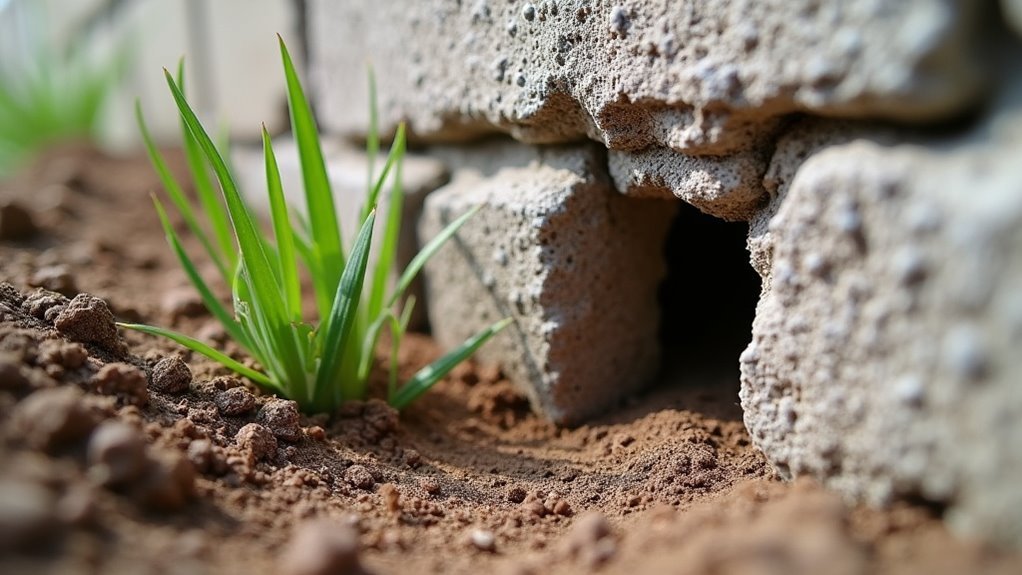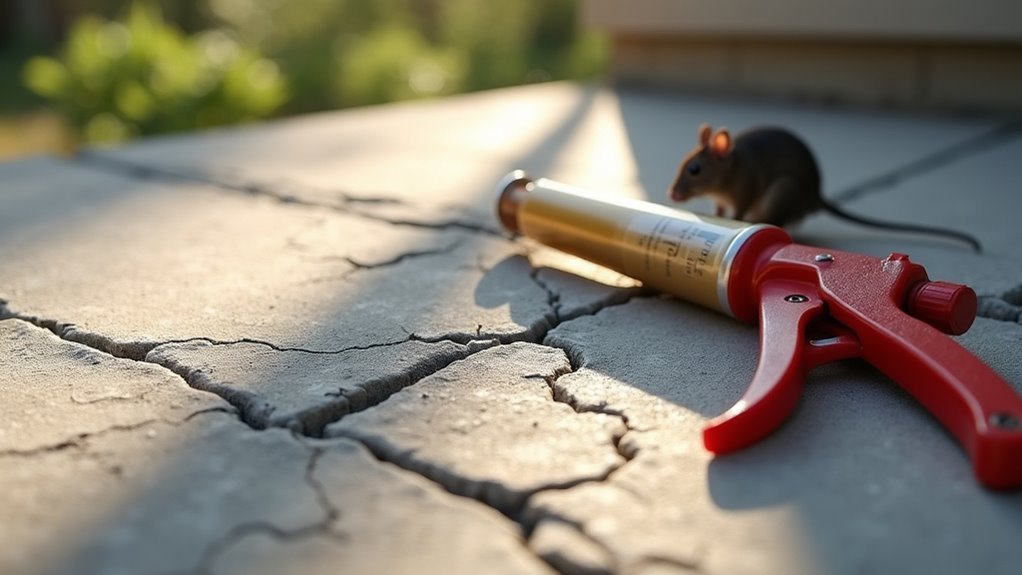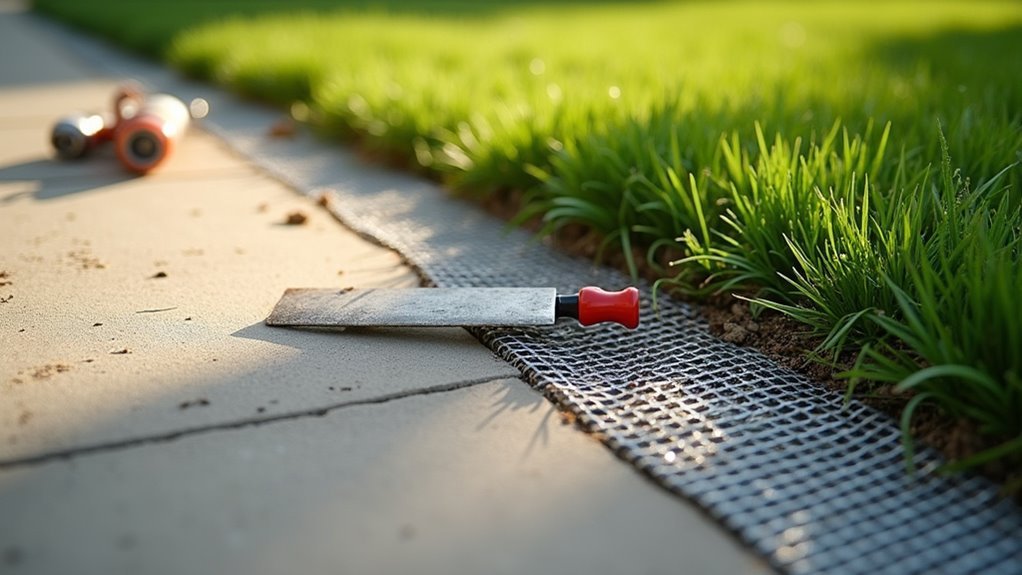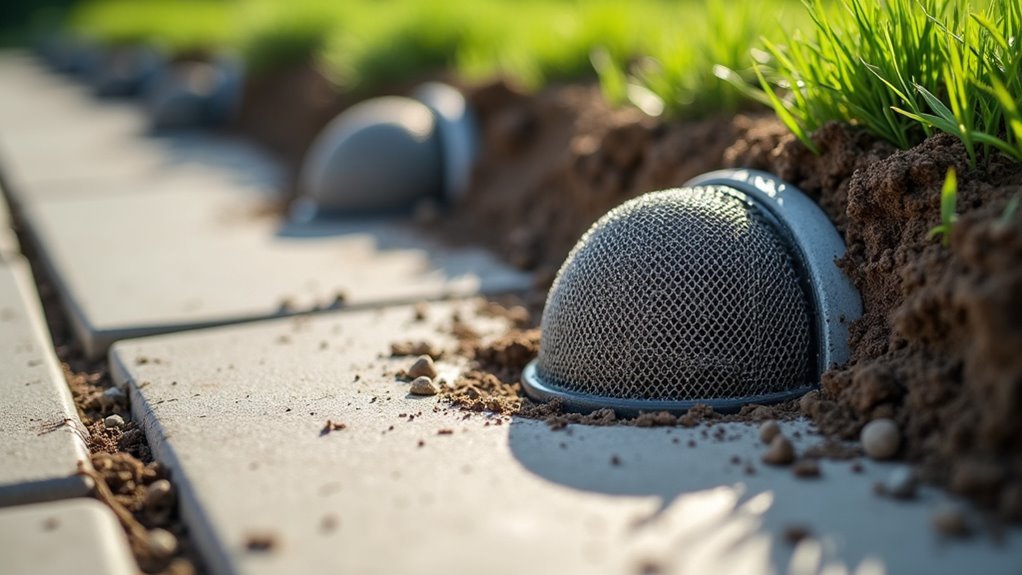Sealing your foundation prevents mice from entering your home through gaps as small as 1/4 inch. You’ll need caulk guns, steel wool, and weatherproof sealants to block entry points around utility lines, pipes, and foundation cracks. Start by inspecting your home’s entire perimeter, focusing on areas where plumbing and electrical lines enter. Use steel wool for larger gaps and caulk for smaller openings, ensuring you maintain these seals regularly as they can deteriorate over time. The complete foundation protection strategy below will safeguard your home year-round.
Why Mice Target Your Foundation First

When mice are searching for a new home, your foundation becomes their first target because it offers the perfect combination of accessibility and shelter.
These persistent rodents can squeeze through gaps in the foundation as small as 1/4 inch, making even tiny cracks viable entry points. Your foundation’s warmth during cold months acts like a beacon, drawing mice who need to escape harsh weather conditions.
Construction imperfections around utility lines create additional vulnerabilities that mice quickly exploit.
If you’ve got clutter or debris near your foundation, you’re providing perfect cover for mice to approach undetected.
Previous infestations leave behind pheromone trails that guide new mice directly to proven entry points, creating a cycle of repeated invasions targeting your foundation’s weakest spots.
Essential Tools and Materials for Foundation Sealing
Three essential categories of tools and materials will determine your success in sealing your foundation against mice infiltration.
Your essential tools include caulk guns for applying sealants precisely, utility knives for cutting materials cleanly, and wire brushes for removing debris from cracks before sealing.
Proper tools ensure precise application and clean cuts when sealing foundation cracks against rodent entry points.
For materials, you’ll need QUIKRETE mortar patching compound to fill larger foundation gaps, weatherproof caulk for smaller cracks, and steel wool to block entry points effectively.
Metal mesh hardware cloth works perfectly for covering exterior vents while maintaining airflow.
Don’t overlook rodent-proof sealants, which provide enhanced protection at utility line openings and other vulnerable spots. These specialized products resist gnawing better than standard materials.
Remember to seal any gaps methodically, and conduct regular inspections to guarantee your sealing materials remain intact and effective against future mouse invasions.
Step-by-Step Foundation Inspection Process

Before applying any sealing materials, you’ll need to conduct a systematic foundation inspection to identify every potential mouse entry point.
Start by walking the entire perimeter of your home, examining foundation walls for visible gaps, cracks, and crevices. Remember that openings as small as a nickel can allow mice access, so keep gaps of any size on your radar.
Pay special attention to areas around utility lines, pipes, and vents where construction gaps commonly occur.
Use air pressure or a pressure washer to clear debris from existing openings, ensuring they’re completely dry before sealing.
Check mortar and cement condition carefully.
This thorough inspection helps you seal your house effectively and prevent mouse infestation before it starts.
Sealing Cracks and Gaps in Foundation Walls
Once you’ve identified cracks and gaps during your foundation inspection, you’ll need to select the right sealing materials and apply them correctly to keep mice out.
The effectiveness of your mouse-proofing depends on choosing appropriate sealants like caulk, expandable foam, or mortar compound based on the size and location of each gap.
Proper application techniques and ongoing maintenance guarantee your foundation barriers remain secure against rodent intrusion over time.
Finding Foundation Entry Points
Where exactly should you focus your attention when searching for mouse entry points around your foundation?
You’ll need to keep a sharp eye out for cracks and gaps as small as 1/4 inch, since mice can squeeze through surprisingly tiny openings.
Start by examining your entire foundation perimeter systematically, paying special attention to areas where different materials meet.
If you have an older home with stone walls, inspect the rubble between stones carefully—these spaces often create hidden pathways.
Don’t forget to check around utility penetrations, basement windows, and door frames. Gaps around pipes and cables are common problem areas that homeowners often overlook.
Once you’ve identified potential entry points, you can seal them effectively using appropriate materials like caulk or expandable foam.
Choosing Proper Sealing Materials
The success of your mouse-proofing efforts depends heavily on selecting the right sealing materials for each type of gap you’ve discovered.
For durable foundation wall repairs, use QUIKRETE mortar patching compound, specifically designed for masonry and outdoor conditions. Small gaps work well with caulk or expandable foam, but larger openings require a different approach.
First, stuff steel wool into bigger gaps before applying your sealing material—this prevents mice from gnawing through. Consider rodent-proof sealants for utility line openings and other vulnerable foundation areas.
Before applying any sealing materials, clean cracks and gaps thoroughly using air pressure or a pressure washer to guarantee proper adhesion and long-lasting protection against rodent entry.
Application and Maintenance Tips
After you’ve gathered your sealing materials, begin by applying caulk or expandable foam to smaller cracks using steady, consistent pressure to guarantee complete coverage.
Clean out dust and debris from foundation cracks before applying any sealant to verify proper adhesion. For larger gaps, stuff steel wool into the opening first, then apply your permanent sealant over it. This prevents mice from gnawing through the material later.
Once you’ve sealed your foundation, establish a regular maintenance schedule. Check for new cracks or gaps every few months, especially after severe weather.
Reapply sealant as needed when you notice deterioration or new openings. Remember that even quarter-inch gaps can allow mice entry, so thorough inspection is essential for maintaining an effective barrier against rodent intrusion.
Securing Utility Penetrations and Pipe Openings
You’ll find that utility penetrations around pipes, cables, and electrical lines create some of the most overlooked entry points for mice in your foundation.
These openings often expand over time due to settling and weather, turning quarter-inch gaps into perfect mouse highways.
Start by examining where utilities enter your home, then select professional-grade sealing materials specifically designed to block rodents while maintaining weatherproof protection.
Identifying Vulnerable Pipe Areas
While pipes and utility lines provide essential services to your home, they also create some of the most overlooked entry points for mice. You’ll need to inspect all utility line openings where cables, pipes, and wires enter your foundation. These areas often develop small gaps during installation or over time due to settling and weather exposure.
Focus on areas where plumbing enters your basement or crawl space, electrical conduits pass through walls, and gas lines penetrate the foundation.
Don’t forget to check around water spigots, dryer vents, and HVAC connections. Since mice can squeeze through openings as small as a nickel, even tiny cracks require attention.
When you seal gaps around these vulnerable areas, you’re eliminating prime access points that rodents commonly exploit to enter your home.
Professional Sealing Materials
Several professional-grade materials can transform vulnerable utility penetrations into impenetrable barriers against mice.
Weatherproof caulk serves as your first line of defense for sealing gaps around utility line openings, providing reliable protection against moisture and small rodents. For enhanced security, rodent-proof sealant offers superior durability and resistance to gnawing.
Xcluder stands out as an exceptional choice—this fill fabric combines stainless steel and poly materials to create an impenetrable barrier that mice can’t chew through.
You’ll find it particularly effective for irregular openings where traditional caulk might fail.
Regular inspections remain essential since settling and wear can create new gaps over time.
Long-Term Maintenance for Mouse-Proof Foundations

Once you’ve sealed your foundation against mice, maintaining these protective measures becomes essential for long-term success.
Regular inspections of your home’s foundation help identify new cracks and weak points before they become entry routes. Check for gaps as small as 1/4 inch, as mice can squeeze through surprisingly tiny openings.
Your sealing methods require periodic maintenance to remain effective. Steel wool in larger gaps and caulk in smaller ones can deteriorate over time.
Clear outdoor debris like wood piles and leaf litter from around your foundation regularly to eliminate potential nesting sites.
Don’t forget utility line openings – routinely inspect and reseal these with weatherproof caulk.
Implement a consistent cleaning routine around your foundation to enhance the adhesion of sealing materials, strengthening your long-term mouse-proofing efforts.
Frequently Asked Questions
How to Seal Foundation to Keep Mice Out?
Inspect your foundation for cracks larger than 1/4 inch. Clean debris from gaps, stuff steel wool into openings, then apply caulk or expandable foam. Use mortar compound for masonry cracks and recheck regularly.
Will Sealant Keep Mice Out?
Yes, sealant will keep mice out if you use rodent-proof varieties and apply them properly. You’ll need to clean gaps first, then regularly inspect and reapply sealant as environmental wear occurs.
How Do I Stop Mice From Digging Under My Foundation?
You’ll need to install metal mesh or hardware cloth around your foundation’s base. Clear debris and vegetation from the perimeter, then fill any gaps with steel wool before sealing with caulk or foam.
How to Stop Mice From Coming Into the House?
You’ll prevent mice from entering by sealing foundation cracks with caulk, stuffing steel wool in larger holes, maintaining door sweeps, covering vents with mesh, and sealing utility openings.
In Summary
You’ve now got the knowledge to mouse-proof your foundation effectively. Remember, prevention’s always easier than dealing with an infestation later. Stay vigilant with regular inspections, especially before winter when mice seek shelter most actively. Don’t ignore small gaps—they’re highways for rodents. Keep your sealing materials handy for quick repairs, and you’ll maintain a mouse-free home year-round. Your foundation’s your first line of defense.





Leave a Reply